2004 VOLKSWAGEN GOLF PLUS Ecu
[x] Cancel search: EcuPage 120 of 541

Never attach two child restraint sys te m s to one top tether strap or top tether anchorage.
Neve r attach a child seat tether strap to a
Never use ch ild restraint top tether
pant restraints.
Never secure or a ttach any luggage or other items to the top teth er anchorages.
a tether o r other strap is used to attach a
c hild restraint to the front passenger seat, make
sure tha t it is not so tight that it causes th e
we ight-se nsing mat for the A dvanced Airbag
T he heavier weight registe red can make the
Advanced Airbag work as though an
adult wer e on the se at and deploy the Adva nced Airbag when it should be s uppressed causing rious or eve n fa tal injury to the child .
If yo u must ins tall a rearward-facin g child seat o n th e fron t passenger seat because of ce ptional circumstances, but th e BAG
Facility .
Note
If you leave the child restraint with the tether strap firml y installed for seve ral days, this could leave a mark on th e upholste ry o n th e seat cu shion and backre st in the area w he re the teth er
s tra p was installed. The upho ls tery would also be permanen tly stretched around th e tether strap.
This applies especiall y to leather seats .
Follow the c hild restraint manufacturer's struction s w he n installing or remo vin g
Unlo ck th e backrest and fold it slightl y ward.
Gu ide th e upper tethe r strap under or along both s ides of the head restraint (depending on th e
c hild restraint model) into th e luggage
the backres t back into its upright position and press it firmly into th e locking
the c hild restraint to the lower chorage points.
priate anch orage.
Tighten the tether strap firml y so that th e child
restraint lies secure ly agai nst the
first read and no te th e introdu ctory infor mation and heed th e o n page
The followin g are som e sou rces of ad ditional formation about child restraint sele ct io n.
advises that th e best child restraint is one that fits your child and fits in your ve hicl e, and whic h you use correctly and co nsis te ntly.
Try before you buy!
Tran sport Tel.: I oder I (613) 998-86 16, wenn man in der Regio n ist.
www .tc.gc.ca/ roadsa fe ty
Sitting properly and safely
Nat io nal Hi gh way Traffic
www.nhtsa.gov
National Tel.:
B e lt
www.carseat.org
Volkswagen
118 119
Page 138 of 541
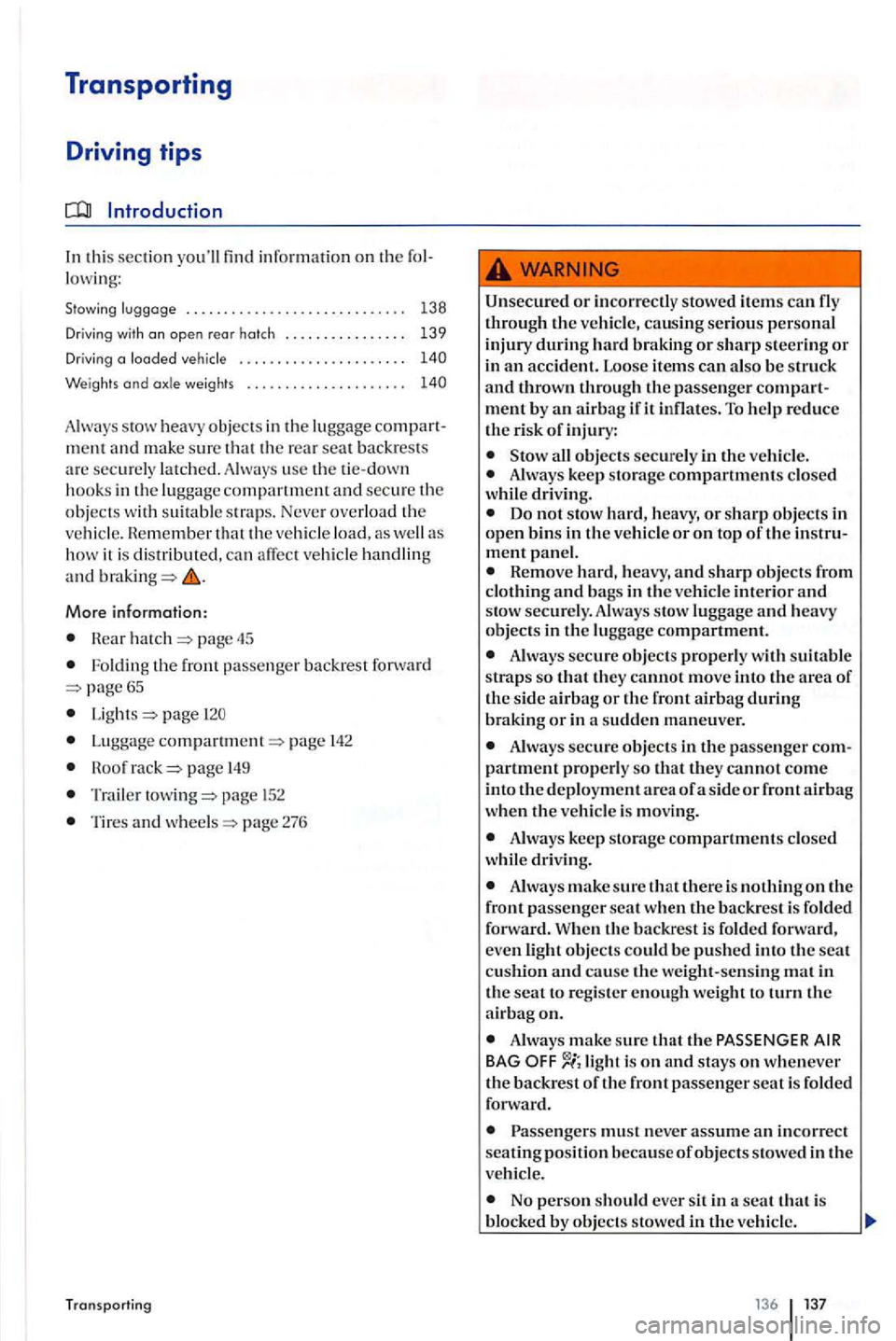
Transporting
Driving tips
In this sec tion yo u'll find informatio n on th e fol
l o w ing:
obj ects in th e luggage m ent and make su re
the vehic le lo ad, as well how it is di stributed, can vehicle hand ling and
page 45
F o lding th e pa sse nger backrest forward
page
Lugg age page
pag e
Trail er pag e
Tires and 27 6
Transporting
Uns ecured or in correc tly s tow ed item s can fly
through the vehicl e, causing serious personal injury during hard braking or sharp s teering or in an a cci dent. Loose items can also be s truck
a nd throw n through the passenge r compartment by an airbag if it infl ate s. To help reduce
the risk of inju ry:
all objects secure ly in the vehicl e. Always keep storage compartments closed dri vin g. Do not stow hard , heavy, or sharp objects in open bins in the ve hicl e or on top of the instrument panel.
A lways secure objects properly with s uitabl e
s traps so that th ey
Always secure objects in the passenger compartment properly so th at they cannot com e
int o the deploy ment area of a sid e or front airbag w hen the vehi cle is m ov ing.
Always keep stora ge compartments closed
w hil e dri ving.
A lways make sure th at the re is nothin g on the front passe nge r sca t w hen the backres t is fo lded forward. When the backres t is folded for ward,
eve n light objects could be pushed int o the scat
c ushion and cau se the we ight- sensin g mat in
th e seat to registe r e n o ugh weig ht to turn th e airbagon.
Always make su re that the AIR BAG
must n eve r assume an incorrec t seating positi on becaus e of objects stow ed in th e vehicle_
No person should ev er sit in a seat that is
blocked by objec ts s towe d in the vehicle.
136 137
Page 139 of 541
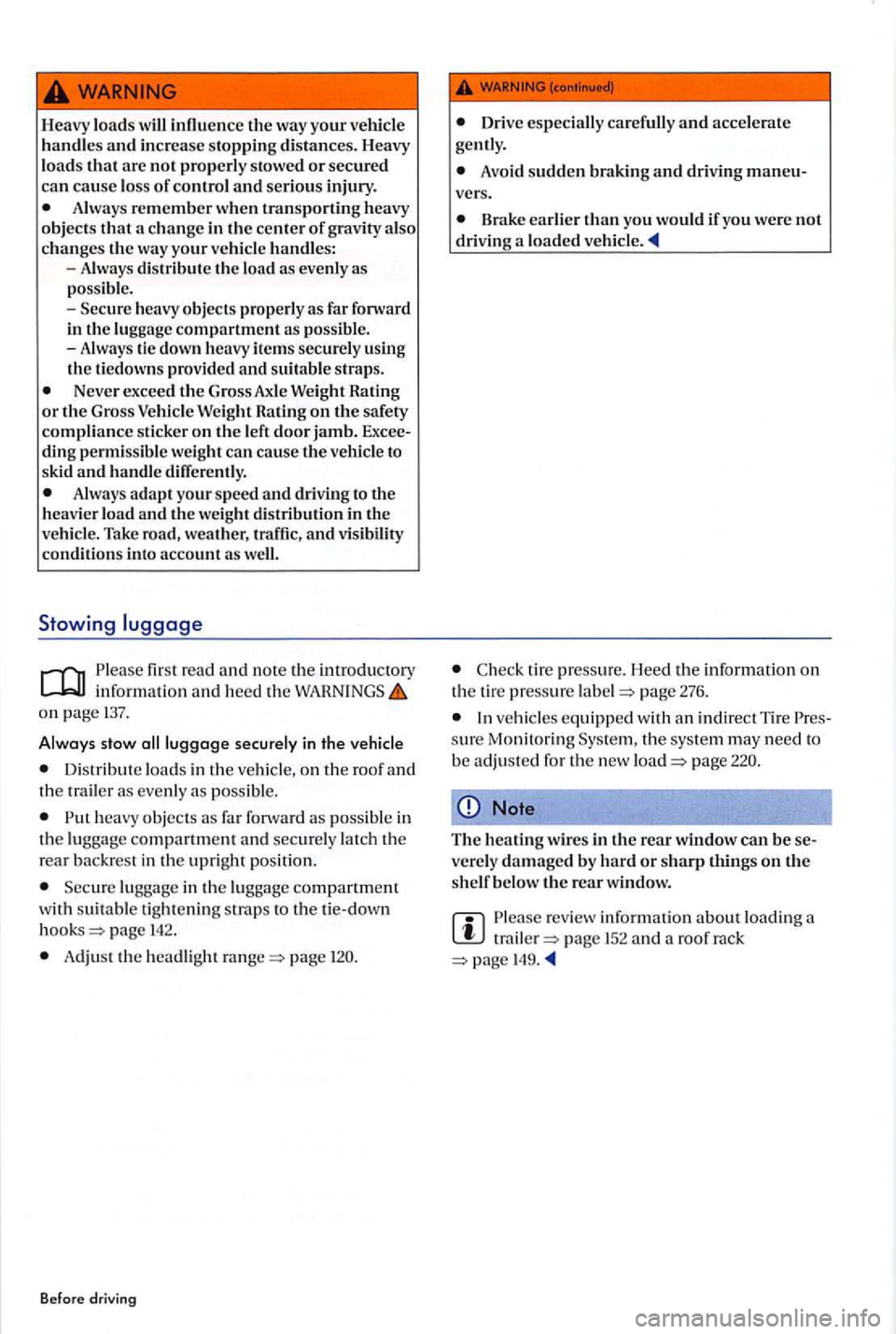
Heavy loads innuence th e way your vehicle handles and increa se stopping distances. Heavy
load s that arc not properly stowed or secured can cause los s of contro l and serious injury . Always remember when transporting heavy
objects that a change in the center of gravity also
changes the way your vehicle handles:
- Always dis tribute the load as evenly as
possib le. -heavy objects properly as far forward
in th e luggage compa rtme nt as possible.
- Always tie down heavy items secure ly using
th e tiedowns provided and suitable straps.
Never exceed th e Gross Axle Weight Rating or the Gross Vehicle Weight Rating on the safety compliance sticker on the left door jamb. Excee
ding permissible weight can cause the vehicle to
skid and handl e diff erentl
y.
Always adapt your speed and driving to th e
heavi er load and the we ight distribution in the
vehicl e. Take road, weathe r, and visibility
cond itions into acco unt as we ll.
Stowing
on page 137.
Always stow all luggage securely in the vehicle
Distribut e loads in the vehicle, on th e roof and the trail er as even ly as possible.
Secu re lu ggage in the luggag e compartment with suit able tightening strap s to the tie-down page 142.
Adjust the headli ght page
Before driving
Drive especia lly carefully and accelerate
gently.
Avoid sudden braking and driving maneu
ve rs.
Brake earlie r than yo u would if you were not driving a loaded
tire pressure. Heed the information on the tir e pressure page 276.
sure Monitor ing Syste m, the system may need to
be adjusted for the new page
CD Note
The heating wires in the rear window can be se
vere ly damaged by hard or sharp things on the sh elf below the rear window.
review inf ormation about loading a page 152 and a roof rack 149.
Page 140 of 541
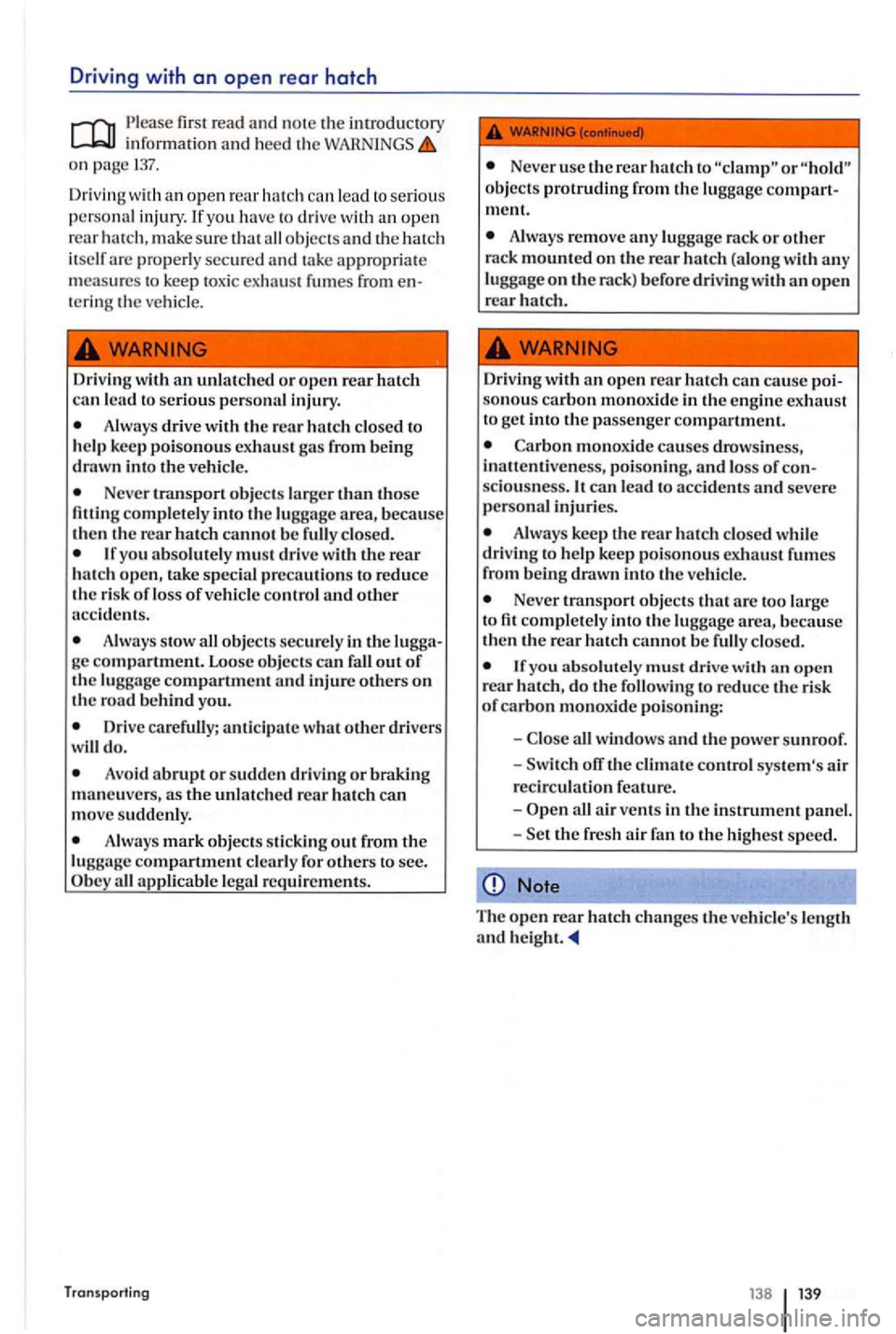
Driving with an open rear hatch
P lease read and not e the introd uctory information and hee d the on pag e 137.
Driv in g w ith an open rear hatch ca n lead to seriou s
perso nal injury. I f yo u have to drive w ith an op en
rear h a tch, make sure that objects an d th e hatch itse lf are properly secured and take appropria te
m easures to keep tox ic exhaust fumes from te rin g th e vehicle .
Driving w
itJ1 an unlatc hed o r open rear hatch
ca n l ead to seriou s pe rso nal injury.
Always driv e witJ1 the rear hatch closed to
h elp kee p poisonou s ex hau st gas from being
drawn into the ve hicle.
Never transport objec ts lar ger than those fittin g co mpletely int o the lu ggage area, beca use then the rear hatch cannot be full y clo sed.
Always stow all objects secu re ly in the
Dr ive care fully; a ntic ipat e what otJ1er driver s will do.
Avoid abrupt o r sudden driv in g or braking maneuv ers, as unla tch ed rear hatch can move suddenly .
A lways mark obje cts sti cking out from the lu ggage compartment clear ly for others to see .
Ob e applicabl e req uirements.
Transporting
Neve r u se the rear ha tc h t o or ob jec ts protruding from the luggage ment.
Alway s remove any lugga ge rack or other
rack mounte d on tJ1e rea r hatch (along with an y
l uggage on th e rack) befor e driving with an ope n
r ea r h atch .
Driving w
ith an open rear hatch can cause sonous carbon mon oxide in the en g in e exhaust
to get into the passe nger compartment.
monoxide cau ses drow sin ess,
inatt enti veness , poison ing , and loss of scio u snes s. can lead to accid ents and seve re
perso na l in juri es.
Always kee p th e rear hat ch closed whil e
driving to help keep poi sonous exha ust fum es
from b ein g drawn into the ve hicl e.
Neve r tran sport obj ec ts that are to o large
t o fit completely int o the lu ggage area, beca use
th en the rear hatch cannot be full y closed.
yo u abso lutely mus t driv e w ith open rea r h atch, do th e
all windows and the powe r sunro of.
- Switc h off the climat e
control sys te m's a ir
recirculation feature.
-
Open all air vents in the in strument pa nel.
- Se t th e fres h air fa n t o th e hi ghest speed.
Note
T he ope n rear hatc h ch anges th e ve hicle's lengt h and he ight .
138 139
Page 141 of 541
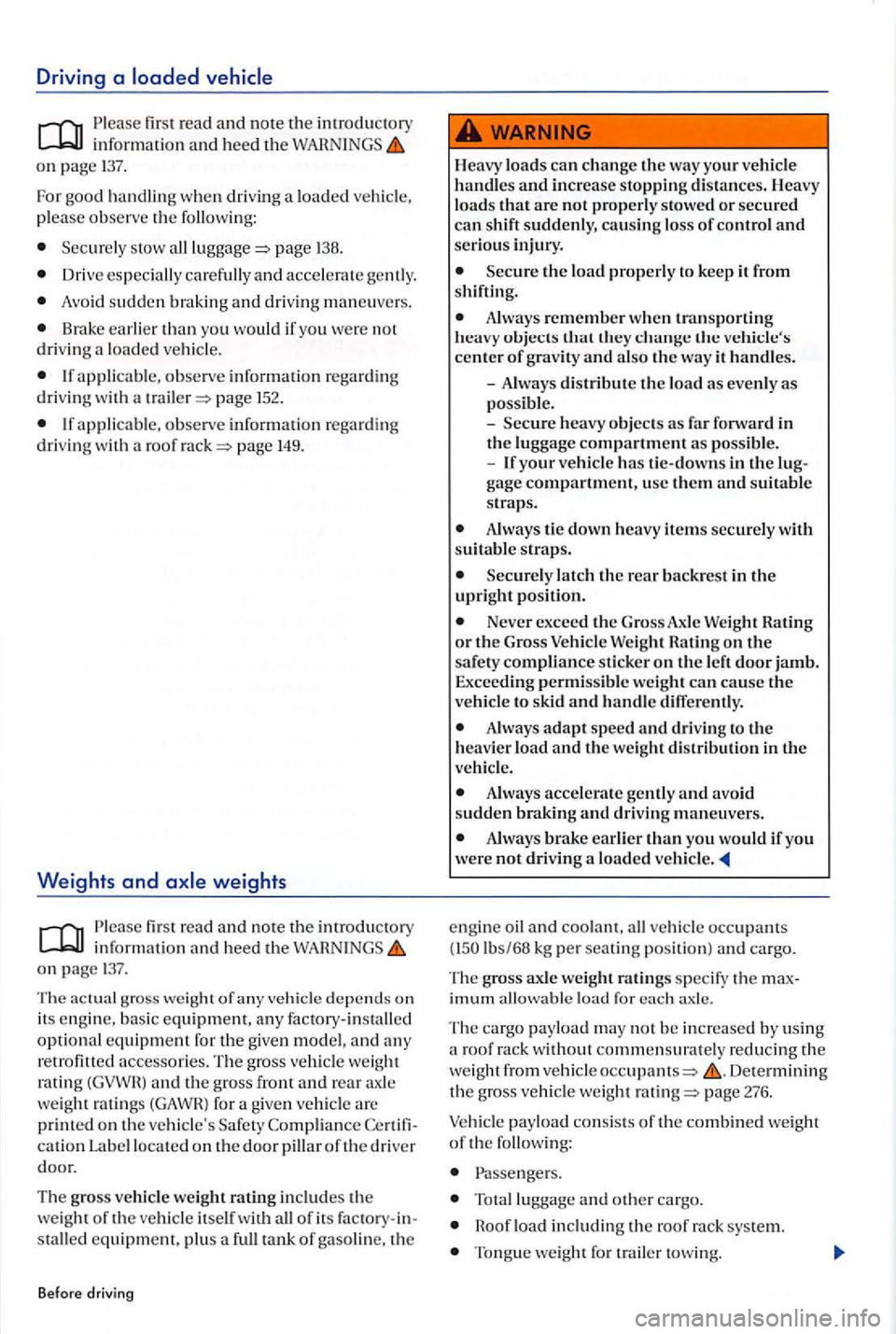
Driving a
first read and note the introductory informat io n and heed the WARNINGS on page 137.
F
or good h andli ng w he n driving a loa ded ve hicl e,
please observe the following:
Secure ly stow page 138.
Dr ive especially caref ully and acce le rate gently.
Avoid sudd en braking and driv ing man eu ve rs.
Brake earlier than you wou ld if yo u were not
drivi ng a loa ded vehicle.
page 152.
If applicabl e, observe information rega rdin g driv in g w ith roof page 149.
Weights and
firs t read and no te the introductory information and heed the WARNINGS o n page 137.
The gross weight of any vehicle depends on its en gin e, basic equipment, an y factory- in stalled
optional equipment for the given model, and any retrofitted accessories. T he gross vehicle weig ht
rat ing
catio n Label loca ted on the door pillar of the dri ver
door.
The gross vehicl e we ight rating includ es the
weight of the ve hicle itself w ith of its tank of gaso line, the
Before driving
lo ads can ch ange the way your vehicle
h andles and incre ase stop ping dista nces. loads that are not properly sto wed or secured can shift suddenly, causing loss of co ntrol and serio us injury.
the load prope rly to keep it from
shifting.
A lways remember w hen tra nsp o rtin g
h eavy obje cts th at th ey vehicle's cente r of gravity and also the way it handles.
- Always dis
tribute the load as eve nly as
possible. -h eavy obj ec ts as far forward in
th e luggage compartment as poss ible. -If your ve hicle has tie-downs in the
Always tie down heavy items securely wit h
s uitable straps.
Secure ly latch th e rear backrest in the upright position .
Never excee d th e Gross Axle Weight Ratin g
o r the Gross Weight Ratin g on the safe ty compliance sti cker on the left door jamb. Exceeding permissi b le weight ca n ca use the
ve hicl e to skid and ha ndl e diff erently.
Always adapt speed and drivi ng to th e
h ea vie r load and th e we ight di stribution in the vehicle.
Always accelerate gently and avo id
s udd en braking an d drivin g maneuvers.
Always brake ea rlier than yo u wo uld if you were not drivin g a loaded ve hicle .
engine oil and coola nt, lbs/68 kg per seatin g position ) and ca rgo .
T
he gross axle weig ht ra tin gs sp ec ify th e imum allowab le load for ax le.
The cargo payload may not be increased by using
a roof rack without commen surat ely reducing th e
we ig ht from vehicle Dete rmin ing
th e gross vehicle weight page 276.
pay load cons is ts of th e co mbin ed w eight of th e following:
Passe ngers.
Tota l luggage and othe r ca rgo .
Roof load including the roof rack system.
Tong ue weig ht for trailer towing.
Page 143 of 541
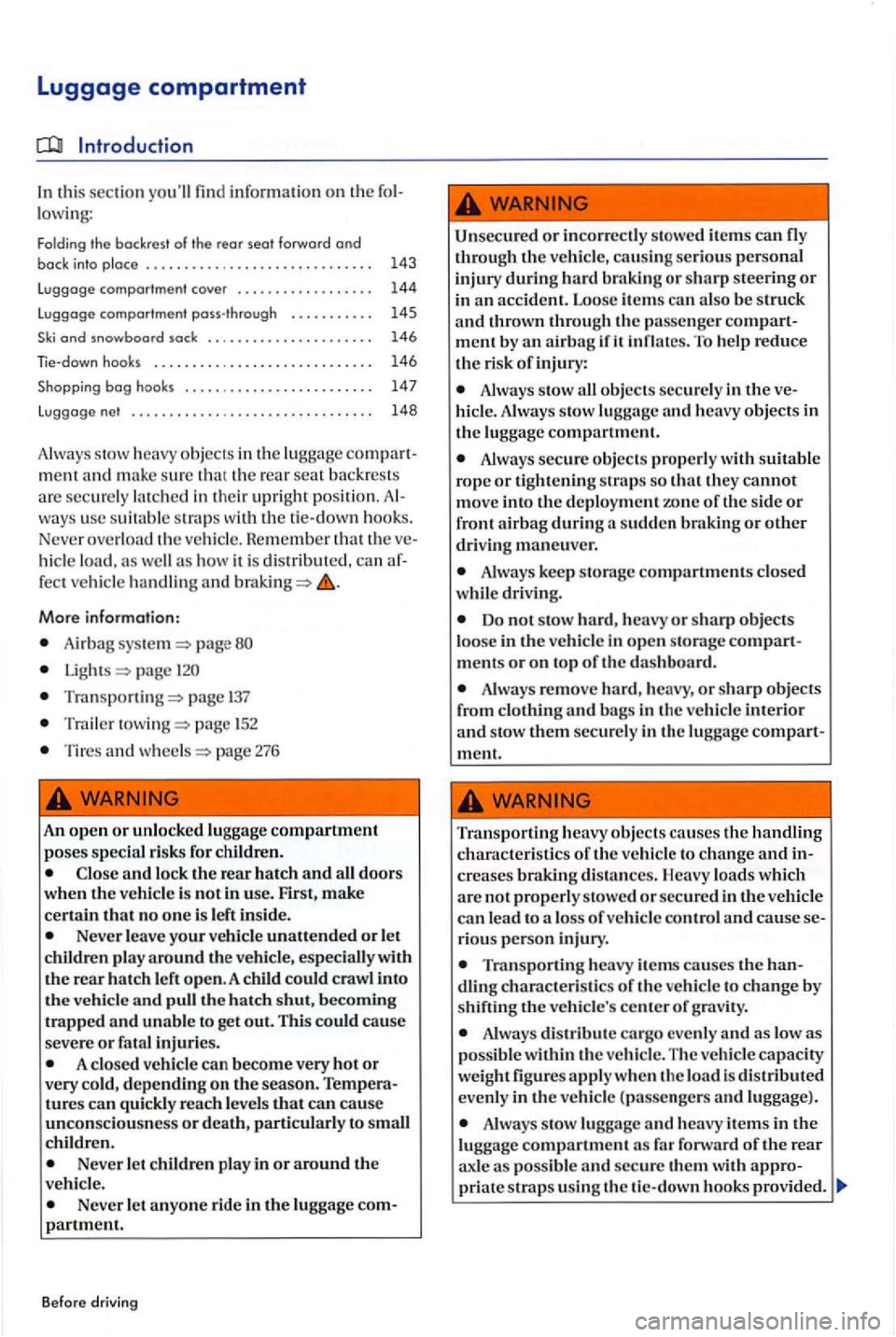
Luggage compartment
Introduction
In this section you'll fin d info rmation on the lowi ng:
Folding the backrest of the rear seat forward and back into place . . . . . . . . . . . . . . . . . . . . . . . . . . . . . . 143
Luggage compartment cover . . . . . . . . . . . . . . . . . . 144
Luggage compartment pass-through . . . . . . . . . . 145
. . . . . . . . . 146
bag hooks . . . . . . . . . . . . . . . . . . . . . . . . . 14 7
Luggage ne t . . . . . . . . . . . . . . . . . . . . . . . . . . .
. . . . 148
A lways stow h eavy objects in the luggage ment and mak e sure tha t th e rear se at back res ts
a re sec urely la tc h ed in their u pright positio n. strap s with the ric- dow n h ooks.
Never ove rload the ve hicle . Remember th at the hi cle load, well it is di str ibu te d , ca n
More info rmation:
A irbag pag e
page
page 137
Trail er page 152
Tires and pa ge 276
An open or unlocked luggage compartment poses sp eci al risks for children. C lose and lock the rear hatch and all doors when the vehicle is not in use. First, make certain that n o one is left insid e. Neve r leave your vehi cle unattende d or l et
childre n play around the ve hicl e, especi ally with the rear h atch left open. A child could crawl into the ve hicl e and pull the hatc h shut, b ecoming trapped and unable to ge t out. Thi s could cause severe or fatal injuries. A clo sed vehicl e can becom e very ho t or very cold, dependin g on the season. tures can quickly re ac h l eve ls that can cau se unconscio usness or death, particul arl y to sm all childr en . N eve r le t childr en play in or around the
veh icle .
Neve r let anyone ride in the lu ggag e partment.
Before driving
Unsecured or incorrec tl y stowe d item s can through the ve hicle, causing seriou s personal injury during hard brakin g or sh arp steering or in an acci dent. Loose item s can als o be s truck
and thrown throug h th e pa sse nger
Always sto w all objec ts sec ure ly in the
Always secu re objec ts prope rly w ith suit abl e
rop e or tightening s traps so that th ey cannot move into the deploy ment zo ne of the side o r
front airbag during a sudden braking or other driving maneu ve r.
Always kee p storage co mpartm ents clo sed
while driving.
Do not sto w hard , h eavy or sh arp objec ts
loo se in the vehicl e in open storage ments or o n to p of the dashboard.
A lways re m ove hard, heavy, or sharp objects
fr o m clothing and ba gs in the vehicl e int erio r
a nd sto w them secure ly in the lu ggage ment.
Tra nsportin g heavy objects causes the handling
c h arac teris tics of th e vehicl e to change and creases braking dista nces. Heavy loads wh ic h are n o t properly stowed or secured in tl1e vehicl e
can l ead to a loss of ve hicle control and cau se ri ous person injury.
T ra nsporting heavy item s ca uses the d ling characteris tic s of the vehicle to change by
s hiftin g the veh icle 's cen te r of g rav ity .
Alwa ys distribute ca rgo eve nly and as lo w as possibl e within the ve hicl e. The vehicl e capacity
we ig ht figures appl y w hen the load is distribute d
even ly in th e ve hicl e (p asse ngers and lugg age).
Alwa ys sto w lugg age and h eavy it e m s in the
lu ggage compartment as far fo n va rd of tl1e rear
axl e as poss ible and secure th em with priate strap s u sin g th e tic- dow n h ooks provided .
Page 145 of 541
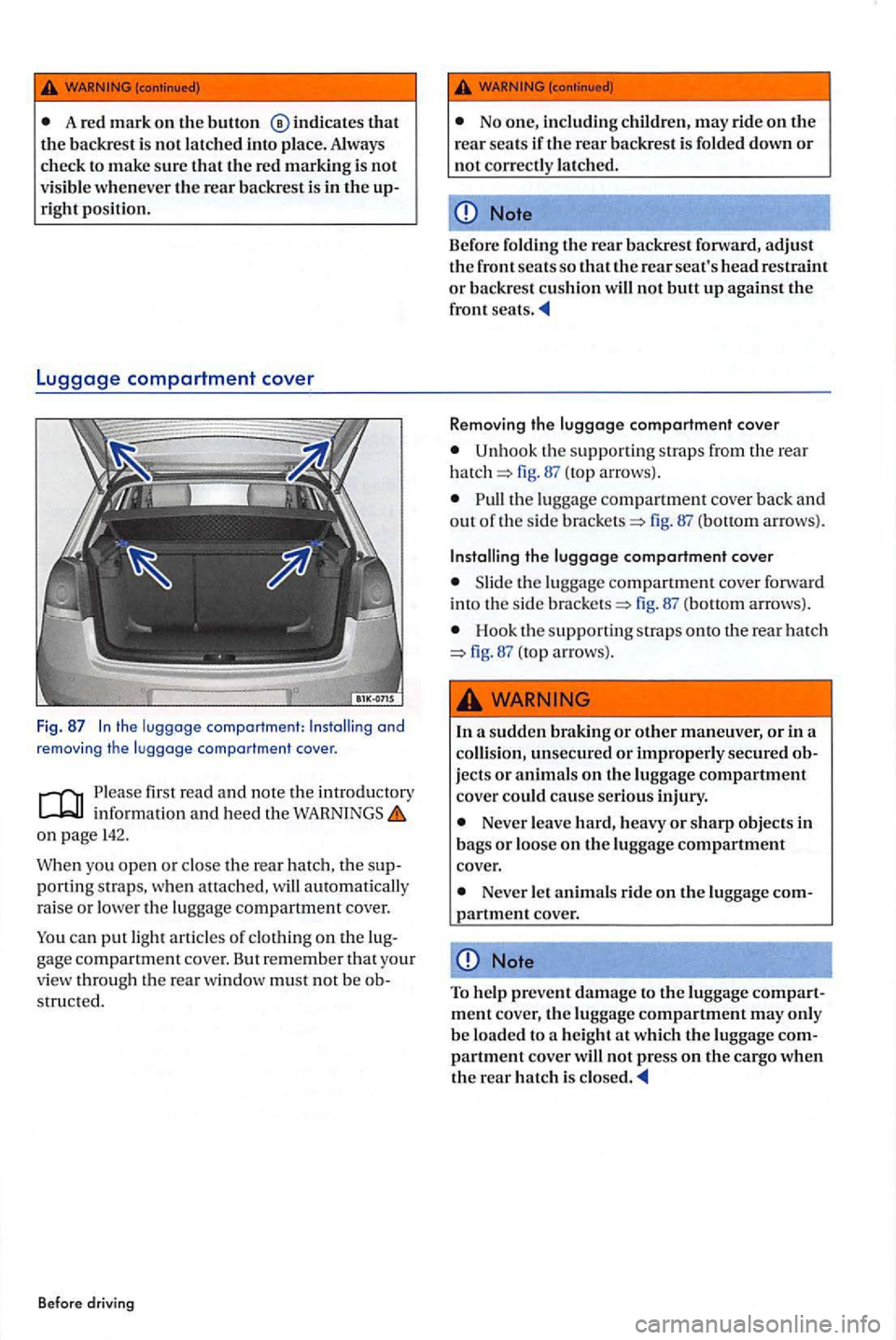
A re d m ark on the button ®indicates that the backrest i s no t l atc h ed int o pla ce. Always
check to m ake sure tha t the re d marking is no t visibl e wh en eve r the rear backrest is in the
the
Pleas e firs t r ead and note the introdu ctory informa tion and heed th e on p age 14 2 .
W hen yo u open or cl ose th e rear hatc h , th e po rti ng straps, w he n att ac h ed . w ill au toma tically
rais e or lo w er th e lugg age co mpartmen t co ver.
You ca n p ut light articles of clot hin g o n th e gage co mpartm ent cove r. B ut rem ember th a t your view th ro ug h th e r ea r window must n ot be
N o one, including
Note
Befo re fo lding th e rear b ackres t forward, adjust the front seats so that th e rear seat's head restraint or backres t cu shi on n ot butt up again st th e
front seats .
R emoving
U nh oo k t he suppo rtin g str ap s from th e rea r 87 (top a rro ws).
Pull th e luggag e compartm ent cover ba ck and out of th e s ide fig. 8 7 (bottom a rro ws) .
Installing the luggage compartment cover
th e lugga ge compartment cover forward
int o th e s id e fig. 87 (bottom arrows).
H oo k th e s upporti ng strap s onto t he rear h a tc h fig. 87 (top arr ows).
a sudde n b raking or otJ1er maneuver , or in a
c olli sio n , unsecured or imprope rl y secured
N eve r le a ve hard , h e avy or s h arp obj ects in
ba gs or loo se o n the lu gg ag e compartment co ver.
Never le t a nim als rid e o n the lu ggage
Note
T o h elp preve nt damage to the luggage m en t cove r, the lu gga ge compartmen t m ay onl y
b e loaded to a he ig ht at whic h th e lu gga ge
Page 147 of 541
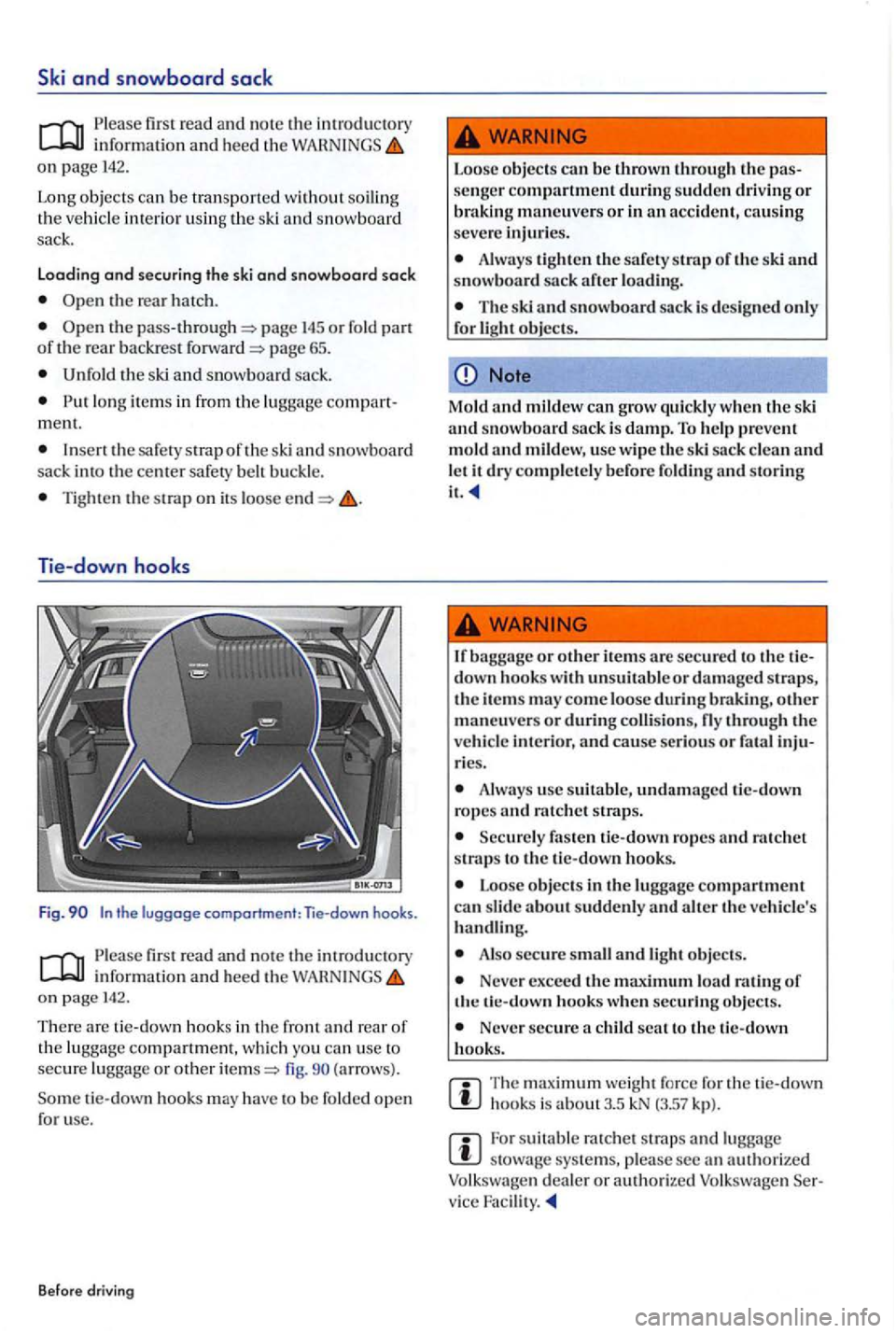
Ski and snowboard sack
Please first rea d and no te the introdu ctory informatio n and heed th e on pag e 142.
Long objects ca n b e tran sported with
out s oiling
t h e vehicl e int erior u sin g th e ski sno wboard
sack.
Loading and sec uring the ski and snowboord sock
the rea r hatch.
the pass -thro ugh
Unfold the ski and snowboard sack.
Put lo ng item s in from th e lugg age ment.
snowboard
s ack into th e center safety belt buck le.
Tighten th e s trap on its loose
Tie-down hooks
Fig. the luggage comportment: Tie-down hooks.
Please first rea d and note th e in trodu ctory informat io n and heed the on pag e 142.
There are tie-d o w n h ook s in the front and rear o f
the l u ggage compartm ent , wh ic h you can use to se cure lu gga ge or other fig. (arrows).
S
ome tie-d own hook s m ay have to b e fold ed open
f o r u se.
Befo re driving
Loose objects be thrown through the
Always tighten the safety of th e ski and snowboard sack after loading.
The ski snowboard sack is de signed only
fori
Note
Mo ld mildew can grow quickly wh en th e ski and snowboard sack is damp. T o he lp prevent mold and mildew, use wipe th e ski sack clean and let it dry completely before fo lding and storing
it.
baggage or oth er item s arc secured to th e down hooks with unsuitabl e or damaged
ries.
Always usc s uit able , undamaged tic-dow n ropes and
Securely fas ten tic-down ropes and ratch e t
stmps to th e tic -dow n hooks.
Loo se o bjec ts in th e lug gage compartm ent
ca n slide about suddenly a nd alter the ve hicl e's
handling.
A ls o secure and lig ht obj ec ts .
Never exceed the maximum load ra tin g o f
th e
Never secure a c hild seat to th e tic-down
h ooks.
The maximum weig ht fo rce for th e tie-down hook s is about3.5 k N (3.57 kp) .
sui table rat ch e t stmp s and luggage stowage syste m s, please sec a n authorized d ealer or authori zed Volksw agen